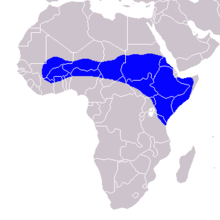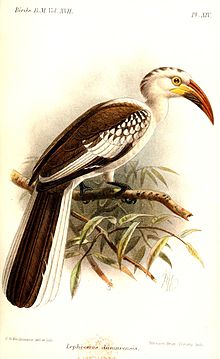Red-billed hornbill
| Red-billed Hornbill | |
|---|---|

| |
| T. erythrorhynchus rufirostris | |
| Scientific classification | |
| Kingdom: | |
| Phylum: | |
| Class: | |
| Order: | |
| Family: | |
| Subfamily: | |
| Genus: | |
| Species: | T. erythrorhynchus
|
| Binomial name | |
| Tockus erythrorhynchus Temminck, 1823
| |

| |
| Distribution of Red-billed Hornbill | |
| Synonyms | |
| |
Red-billed Hornbill (Tockus erythrorhynchus) is a relatively small species of hornbill found in savanna and woodland of sub-Saharan Africa. It is sometimes split into five species, the Northern Red-billed Hornbill (T. erythrorhynchus), Western Red-billed Hornbill (T. kempi), Tanzania Red-billed Hornbill (T. ruahae), Southern Red-billed Hornbill (T. rufirostris) and Damara Red-billed Hornbill (T. damarensis), but at present most authorities considered them all to be subspecies of a single species.



Description
This conspicuous bird has mainly whitish underparts and head, and grey upperparts. It has a long tail and a long and curved red bill which lacks a casque. Sexes are similar, but the female has a smaller bill. It is a large bird, at 42 cm long, but is one of the smaller hornbills. It advertises its presence with its noisy accelerating tok-tok-tok-toktoktok call.
Behaviour
Breeding
During incubation, the female lays three to six white eggs in a tree hole, which is blocked off with a plaster of mud, droppings and fruit pulp. There is only one narrow aperture, just big enough for the male to transfer food to the mother and the chicks. When the chicks and the female are too big to fit in the nest, the mother breaks out and rebuilds the wall, then both parents feed the chicks.
Feeding
This species is omnivorous, taking insects, fruit and seeds. It feeds mainly on the ground and will form flocks outside the breeding season.
In popular culture
- Zazu, a character in the animated film The Lion King, is a red-billed hornbill. He is also featured in the sequel, The Lion King II: Simba's Pride and the mid-quel The Lion King 1½.
References
- Template:IUCN2006 Database entry includes justification for why this species is of least concern
- Birds of The Gambia by Barlow, Wacher and Disley, ISBN 1-873403-32-1
External links
- Red-billed Hornbill videos, photos & sounds on the Internet Bird Collection

